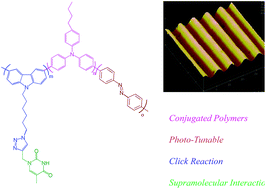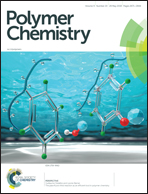Stimuli-responsive supramolecular conjugated polymer with phototunable surface relief grating†
Abstract
We have used a facile method to prepare azobenzene- and (bio-inspired) thymine (T)-functionalized conjugated copolymers (PTCAz-T) through Suzuki coupling polymerization and click reactions. The glass transition temperature of PTCAz-T is increased after performing the click reactions, compared with that of its precursor T-free PTCAz-N3 conjugated copolymer, because the strong T–T interactions restricted the molecular motion, decreased the free volume, and provided a more stable morphology. The presence of the azobenzene units in the main chain of the conjugated polymer presenting the T units resulted in amorphous phase behavior without macro-phase separation, and allowed the preparation of homogeneous photo-controllable thin films exhibiting stimuli-responsive behavior through photo-induced trans-to-cis isomerization. In addition, we use the conjugated copolymer PTCAz-T to prepare surface relief gratings displaying long-range-ordered interference patterns. Thus, such materials have potential applications in optical storage media while also providing a pathway for further supramolecular development.



 Please wait while we load your content...
Please wait while we load your content...